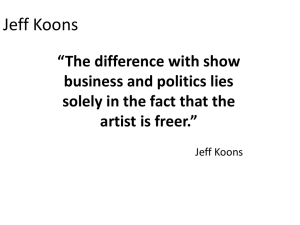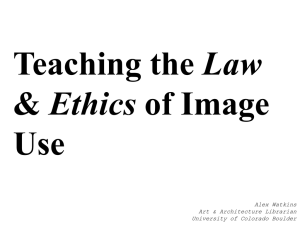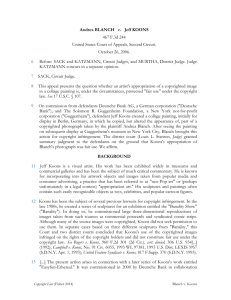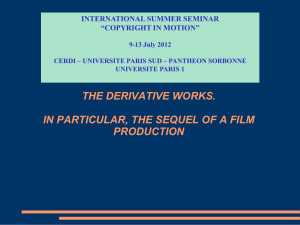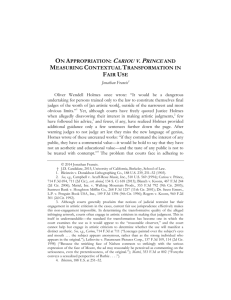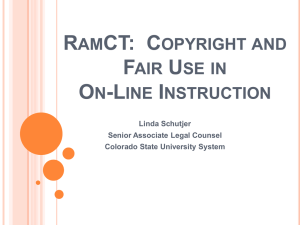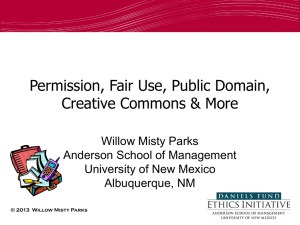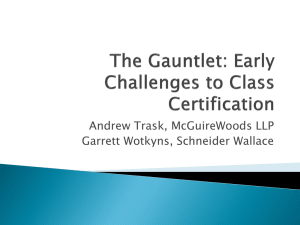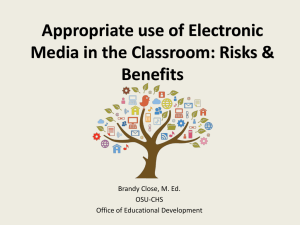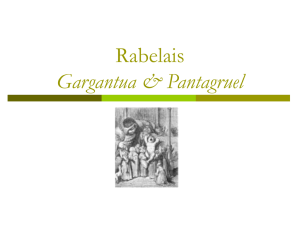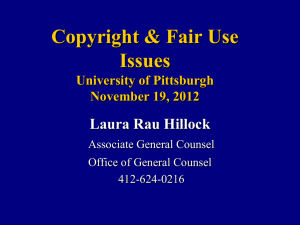Class Outline
advertisement
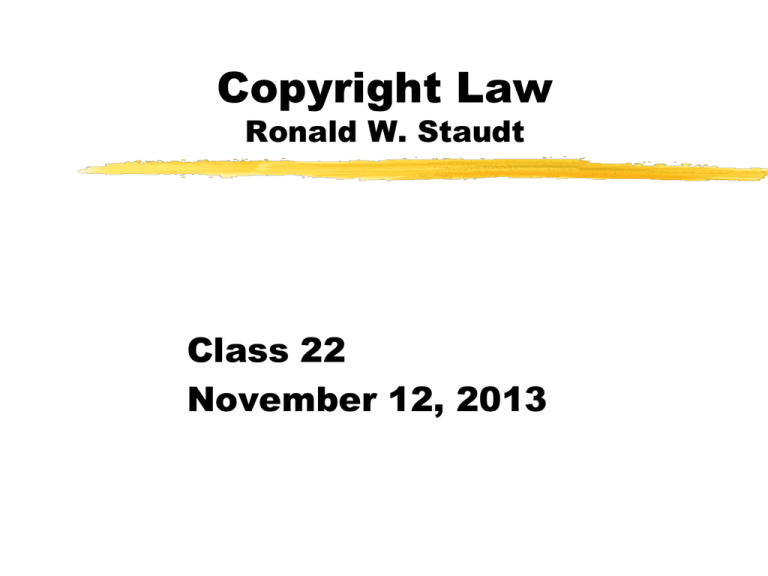
Copyright Law Ronald W. Staudt Class 22 November 12, 2013 § 107. Limitations on exclusive rights: Fair use Notwithstanding the provisions of sections 106 and 106A, the fair use of a copyrighted work, including such use by reproduction in copies or phonorecords or by any other means specified by that section, for purposes such as criticism, comment, news reporting, teaching (including multiple copies for classroom use), scholarship, or research, is not an infringement of copyright. § 107. Limitations on exclusive rights: Fair use (cont.) In determining whether the use made of a work in any particular case is a fair use the factors to be considered shall include— (1) the purpose and character of the use, including whether such use is of a commercial nature or is for nonprofit educational purposes; (2) the nature of the copyrighted work; (3) the amount and substantiality of the portion used in relation to the copyrighted work as a whole; and (4) the effect of the use upon the potential market for or value of the copyrighted work. § 107. Limitations on exclusive rights: Fair use (cont.) The fact that a work is unpublished shall not itself bar a finding of fair use if such finding is made upon consideration of all the above factors. Koons’ Niagara Blanch v. Koons, 467 F. 3d 244 (2d Cir. 2006) But Koons asserts -- and Blanch does not deny - that his purposes in using Blanch's image are sharply different from Blanch's goals in creating it. Compare Koons Aff. at P4 ("I want the viewer to think about his/her personal experience with these objects, products, and images and at the same time gain new insight into how these affect our lives.") with Blanch Dep. at 112-113 ("I wanted to show some sort of erotic sense[;] . . . to get . . . more of a sexuality to the photographs."). Koons’ Niagara Blanch v. Koons, 467 F. 3d 244 (2d Cir. 2006) “Koons is, by his own undisputed description, using Blanch's image as fodder for his commentary on the social and aesthetic consequences of mass media. His stated objective is thus not to repackage Blanch's "Silk Sandals," but to employ it "'in the creation of new information, new aesthetics, new insights and understandings.'" Transformative v. derivative– new function? Parody v. satire – Quoting v. paraphrasing Koons- String of Puppies Rogers v. Koons, 960 F. 2d 301, 309 (2d. Cir 1992) “Koons argues that his sculpture is a satire or parody of society at large. He insists that "String of Puppies" is a fair social criticism and asserts to support that proposition that he belongs to the school of American artists who believe the mass production of commodities and media images has caused a deterioration in the quality of society, and this artistic tradition of which he is a member proposes through incorporating these images into works of art to comment critically both on the incorporated object and the political and economic system that created it. These themes, Koons states, draw upon the artistic movements of Cubism and Dadaism, with particular influence attributed to Marcel Duchamp, who in 1913 became the first to incorporate manufactured objects (readymades) into a work of art, directly influencing Koons' work and the work of other contemporary American artists.” Cariou v. Prince Facts DC held no fair use – Appropriation art not per se fair use – D’s work must comment on P’s to be transformative – D said his purpose was the same at P’s to communicate – D uses other people’s originals to “reduce speculation.” 2d Cir Reverses – Prince’s testimony on transformativeness is not conclusive– critical fact is how the works appear to the reasonable observer Cariou v. Prince 2d Cir Need not comment on Cariou or culture or even testify that he is trying to do so. Focusing on the art, 25 are transformative as a matter of law! Show cancellation a misunderstanding– P and D not in same market. P can’t get Brangelina, DeNiro, Brady and Bundchen! J.K. Rowling and the Lexicon Warner Bros. Entm't Inc. v. RDR Books, 575 F. Supp. 2d 513 (2008) Rowling’s publications The Lexicon Prima Facie Case Improper appropriation Derivative work? Fair Use Do the 4 factors Bill Graham Archives Grateful Dead posters? Like thumbnails?- D’s licencing fee as 4th factor impact? “…traditional, reasonable, likely to be developed markets” Harper & Row v. Nation Facts and more facts and more Majority Opinion Incentives worked Implied consent/lack of consent/criticism But unpublished traditionally different 106(3) and 107 and pari materia “key but not necessarily determinative factor” “Under ordinary circumstances the author’s right to control the first public appearance of his undisseminated expression will outweigh a claim of fair use” 1st Amendment & public figure exception to © Harper & Row v. Nation 4 factors 1: news v. commercial (see Sony repositioning-”separate factor that tends to weigh against a finding of fair use”) and intentionally aimed to scoop P’s licensee via theft 2: factual work v. unpublished • Unpublished nature of work is a “key but not necessarily determinative factor” • Under ordinary circumstances the author’s right to control the first publication of his undisseminated expression will outweigh a claim of fair use. 3. Expressive value of vebatim 300 words (13%) • “the heart of the book” 4:”single most important element of fair use” actual harm, expression v. fact Harper & Row v. Nation Dissent Literary form v. ideas or information Categorical presumption against prepublication fair use Questions and note cases Craft v. Kobler Copier not at liberty to avoid “pedestrian” reportage by appropriating his subject’s literary devices Critical v. decorative use Castle Rock Facts 4 factors 1:Transformative purpose? 2: Expressive nature 3: Amount used consistent with purpose? 4: Market effect: suppression or destruction v. usurpation or substitution Parody? The Joy of Trek P didn’t go there? Market abandonment? Clean Flicks Exclusive right? First sale doctrine? Market harm in fair use analysis Derivative works and transformative usesmore confusion? See Professor Reese’s article cited at page 866. R. Anthony Reese, Transformativeness and the Derivative Work Right, 31 Colum. J. L. & Arts 467 (2008). Transformative for fair use and derivative works in 106(2) The central purpose of this investigation is to see…whether the new work merely "supersede[s] the objects" of the original creation…("supplanting" the original), or instead adds something new, with a further purpose or different character, altering the first with new expression, meaning, or message; it asks, in other words, whether and to what extent the new work is "transformative.“ Campbell v. Acuff-Rose Music, 510 U.S. 569 A “derivative work” is a work based upon one or more preexisting works, such as a translation, musical arrangement, dramatization, fictionalization, motion picture version, sound recording, art reproduction, abridgment, condensation, or any other form in which a work may be recast, transformed, or adapted. A work consisting of editorial revisions, annotations, elaborations, or other modifications which, as a whole, represent an original work of authorship, is a “derivative work”. 17 U.S.C. 101 Overview by result Campbell- parody –fair Koons sculpture – unfair Koons painting – fair Air Pirates – Mickey Mouse spoof- unfair Mattel – Food Chain Barbie - fair Harper- prepublication scoop –unfair Bill Graham – Grateful Dead posters – fair Castle Rock- SAT –unfair Clean Flicks- sanitized films – unfair Harry Potter Lexicon- transformative but excessive- unfair Leaffer Synthesis of Fair Use Noncommercial commercial Transformative Easiest fair use Reproductive Hard cases: Sony Betamax Hard cases: Campbell Harper & Row Easiest no fair use
